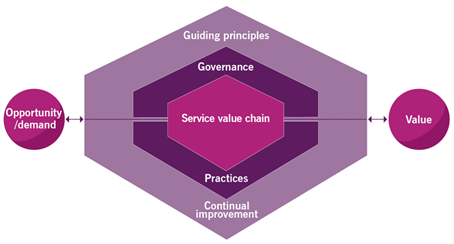
Selling the Value of ITIL 4
In terms of the IT service management (ITSM) opportunities available to organizations to improve their IT service delivery and support operations and outcomes, ITIL is definitely the most mature. It’s been used by organizations of all sizes around the world for over 30 years, with 2020’s ITIL 4 the most recent incarnation of the core best practice guidance, with supplementary guidance on “Acquiring & Managing Cloud Services,” “Business Relationship Management”, “IT Asset Management,” and “Sustainability in Digital & IT” created since.
However, despite ITIL’s popularity, you might still need to sell the value of ITIL within your organization. Convincing key business stakeholders of the difference ITIL adoption will make at a business level and not simply in delivering “better, faster, cheaper” IT operations.
Despite ITIL’s popularity, you might still need to sell the value of ITIL 4 within your organization. This blog by @Joe_the_IT_Guy aims to help. #ITSM #ServiceDesk Click To TweetA quick introduction to the key elements of ITIL
While many will think of ITIL as the various pieces of ITSM process guidance, such as incident management or knowledge management, it offers far more.
The starting point is that ITIL focuses on delivering technology as a service rather than the technology itself. ITIL 4 has extended this, with the focus of ITIL 4 now on value co-creation. This latest version of ITIL is comprised of the:
- Service value system, which houses all of the other elements
- Service value chain, which is a set of interconnected activities that turn customer demand into customer value
- Four dimensions of service management, which are essential for the effective management of IT services
- Guiding principles, which help service provider organizations to focus on what’s most important
- 34 management practices, where best practice guidance is shared across general, service, and technical management practices.
The traditional ITIL emphasis of ITIL on people, processes, and technology (plus partners) still applies, with the value of ITSM tools, in particular, increased as organizations extend their ITSM capabilities to other business function opportunities via enterprise service management strategies.
Selling ITIL to key business stakeholders
It’s likely that global ITIL adoption levels and the top-level ITIL benefits, while interesting, will not be sufficient to sell it to key business stakeholders. Especially when ITIL is competing with what might seem like more-practical opportunities to improve business operations and outcomes. To help, this blog considers how the different ITIL 4 elements will be valuable to your organization.
Here @Joe_the_IT_Guy explains how the different ITIL 4 elements will be valuable to your organization. #ITSM #ServiceDesk Click To TweetITIL “thinking”
The adoption of ITIL has long brought technology provision closer to the business, with the focus on the use of the technology placed ahead of the technology itself. It means that technology is delivered in a way that recognizes the business need over the technological capabilities. But this is just the start of the value of ITIL, with the use of ITSM best practice guidance – such as incident management, problem management, and change enablement – helping IT organizations to improve their IT service delivery and support capabilities. The benefits here are not simply greater operational efficiency that reduces costs but also consistency that improves outcomes and customer satisfaction and reduces risk.
'The benefits of ITIL are not simply just greater operational efficiency that reduces costs but also consistency that improves outcomes & customer satisfaction and reduces risk.' - @Joe_the_IT_Guy #ITSM #ServiceDesk Click To TweetThe ITIL service value system
The issue with conveying the value of the ITIL service value system is that it’s easy to jump straight into the value of its parts. So, it’s worth stopping with the ITIL service value system for a moment to appreciate that it’s a value creation architecture that hopefully allows ITIL-adopting organizations to understand that ITIL is about more than process adoption (as shown in the image below).

Source: Axelos, “ITIL Foundation: ITIL 4 Edition” (2019)
Therefore, the ITIL 4 service value system offers a unique value proposition to organizations. First, moving service-provider mindsets from the ITSM processes that can be employed for “better, faster, cheaper” IT service delivery and support. Second, in focusing service management on the co-creation of value.
The ITIL service value chain
The ITIL service value chain sits at the heart of the ITIL service value system and can be considered the value-creation “engine.” Importantly for ITIL adopters, the ITIL service value chain helps service providers to better understand the end-to-end value streams for delivering IT services. As with the ITIL service value system, it elevates thinking and knowledge above the traditional ITSM processes so that service providers know what’s most important and where value is co-created.
The four dimensions of service management
Again, as with the ITIL service value system, the four dimensions of service management elevate service provider thinking and activities beyond ITSM processes. For example, the organizational dimension helps align IT services with business goals to create more value. The information dimension focuses on the importance of accurate and timely information for better decision-making. The people dimension emphasizes the importance of the people to IT service delivery and support, including optimizing efficiency and productivity. Finally, the technology dimension recognizes the need for best practices for technology management and the importance of ITSM tools to the operation and success of ITIL’s service management practices.
In this blog @Joe_the_IT_Guy looks at the value that the different parts of ITIL 4 offer an organization, including the service value chain, four dimensions, & 7 guiding principles. #ITSM #ServiceDesk Click To TweetThe seven ITIL guiding principles
While the seven ITIL guiding principles might appear simple, their application is both powerful and valuable. They can be considered a decision-making checklist for service management. For example, the “focus on value” principle helps to understand and deliver IT service value. “Start where you are” emphasizes the importance of using the existing resources and capabilities and “progress iteratively with feedback” the importance of continuous improvement.
The business value of employing these guiding principles should not be underestimated or ignored.
The 34 ITIL management practices
I’ve deliberately left the management practices to last. They’re extremely valuable to organizations, but their value diminishes if used in isolation. This commonly happened with ITIL v3/2011 adoption – the ITSM processes were adopted individually and often not without the overarching service management concepts.
The value of the management practices is also adversely affected without fit-for-purpose ITSM tooling to help automate tasks and activities and to improve reporting and analytics and the delivered employee experience. This not only applies to the application of ITIL and the ITSM tool to IT but also to other business functions such as finance, legal, human resources (HR), and facilities where the corporate value of ITIL adoption is increased.
The 34 ITIL management practices are extremely valuable to organizations, but their value diminishes if used in isolation, says @Joe_the_IT_Guy. Here he explains more. #ITSM #ServiceDesk Click To TweetSelling the overall value of ITIL adoption
In addition to articulating the value of the different ITIL elements, there’s a key rule for selling ITIL to key business stakeholders. This is to recognize that the value of ITIL isn’t in what’s done but in what it helps a service provider to achieve. So, when selling the value of ITIL, don’t talk in terms of more efficient incident or change handling. Instead, focus on the better business outcomes, whether better margins and profitability, improved customer experiences and retention, reduced risks, greater agility and innovation, or something else important to the business vision and goals.
Anything else to add? Please let me know in the comments.






